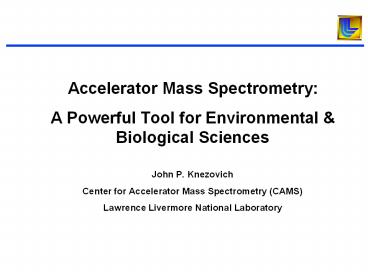Accelerator Mass Spectrometry: - PowerPoint PPT Presentation
1 / 17
Title:
Accelerator Mass Spectrometry:
Description:
Center for Accelerator Mass Spectrometry (CAMS) Lawrence Livermore National Laboratory ... CAMS Facts. Most versatile and productive AMS facility in the world ... – PowerPoint PPT presentation
Number of Views:786
Avg rating:3.0/5.0
Title: Accelerator Mass Spectrometry:
1
- Accelerator Mass Spectrometry
- A Powerful Tool for Environmental Biological
Sciences - John P. Knezovich
- Center for Accelerator Mass Spectrometry (CAMS)
- Lawrence Livermore National Laboratory
2
Understanding the past, exploring the future
3
What is Accelerator Mass Spectrometry?
- A highly sensitive and precise technique for
measuring isotope ratios - Separates and counts atoms instead of measuring
radioactive decay - Unmatched sensitivity
- Can quantify attomoles of atoms (i.e., 10-18 M)
- Small sample size (lt1mg)
- Rapid analysis time (mins.)
- Isotopes can be used as chronometers and tracers
- Applications are only limited by the ingenuity of
the researcher
4
CAMS Facts
- Most versatile and productive AMS facility in the
world - Routine measurement of 3H, 10Be, 14C, 26Al, 36Cl,
41Ca, 63Ni, 99Tc,129I, 239Pu - 20,000 analyses performed per year
- Contribute to national needs in carbon
sequestration, climate change, geo- and
bio-sciences - Recently named a National Center for biomedical
applications
5
Isotopes are accelerated and separated based on
their mass
6
CAMS 10-MV AMS System
7
Bomb Radiocarbon as a Tracer of Global
Environmental Processes
8
El Niño - Can we measure its frequency?
NORMAL
El Niño
STRONG TRADE WINDS EAST-WEST THERMOCLINE
GRADIENT UPWELLING IN EASTERN EQ. PACIFIC
WEAK OR REVERSED TRADE WINDS REVERSED THERMOCLINE
GRADIENT LITTLE OR NO UPWELLING IN EAST
9
Corals as monitors of oceanic processes
Radiocarbon (14C) is a conservative water tracer,
and is not influenced by biology Coral skeletal
14C water 14C
Therefore, corals should be able to tell us how
rapidly CO2 is absorbed by the ocean and to what
extent the ocean mixes
10
High-Resolution Coral 14C Tracks Ocean
Circulation Climate
11
We are at the forefront of a revolution
- Physics Loses Limelight to Biology U.S. News
World Report, March 29 (1999) - U.S. Universities are now promoting
collaborations between physics and biology
Nature 3973 (1999) - Biosciences now account for gt43 of federal
funding for basic research (up from 30 in 1970) - An aging population coupled with increased needs
for health care are fueling this trend
12
Pressing questions
- Toxicology, Pharmacology, Nutrition
- Are data obtained from high-dose experiments
relevant? - Is it possible to determine the impact of low,
environmentally-relevant exposures? - Are animal models valid?
- Are studies with human subjects feasible?
- AMS provides the sensitivity and precision needed
to address these questions
13
The amount of a mutagen formed in grilled food
was used to determine its potential risk to
humans
14
A single dose of folate was traced for 200 days
Folate incorporation begins at day 5 and serves
as an index of blood cell life time
15
Where do we go from here?
- AMS has the sensitivity and precision to address
a multitude of environmental and biomedical
questions - Merging the fields of physics, chemistry and
biology (as well as others) will continue to
create new insights and opportunities - Newer, smaller spectrometers will proliferate
over the next ten years
16
CAMS Spectrometers
17
Radiocarbon Dates for Teachers! Free!!! From the
Center for Accelerator Mass Spectrometry Lawrence
Livermore National Laboratory PROPOSAL DEADLINE
November 1, 2000 (Samples should be between 350
and 50,000 years old)































